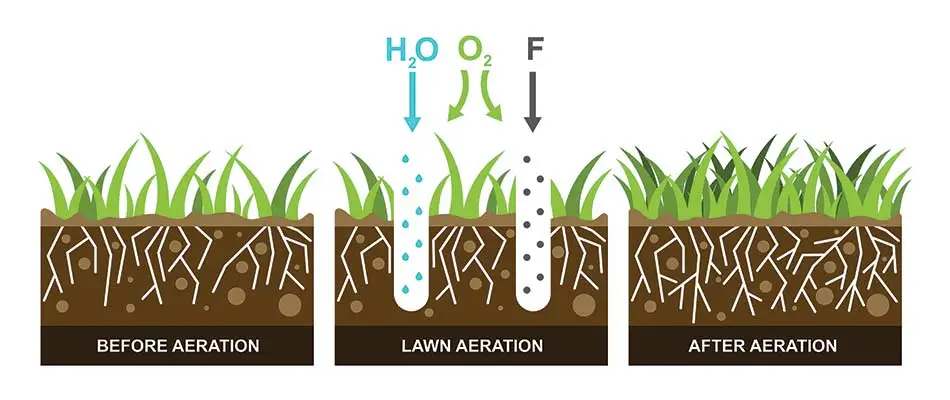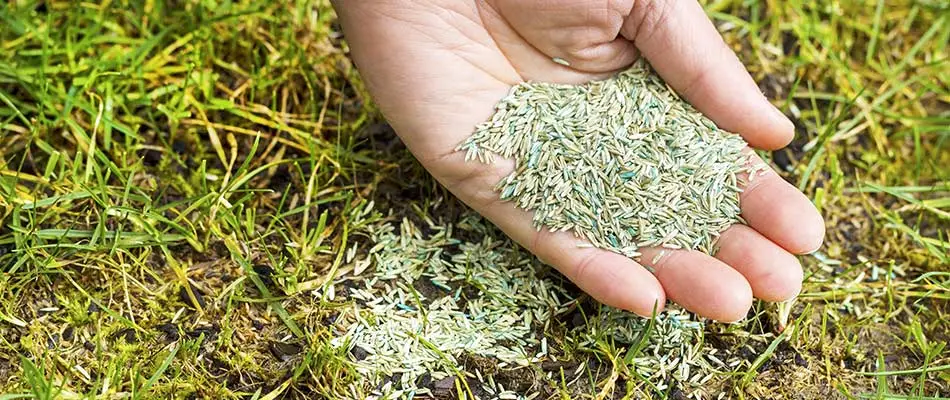Even the best lawns face challenges, and one of the best ways to combat them or avoid them entirely is to keep your grass strong and healthy. To many people, that simply means regular mowing and watering, pulling weeds, and applying fertilizers.
Yes, those are important things, but they’re not enough. Missing from that formula is overseeding and aeration as regularly planned treatments. Together, they refresh your turf and create the conditions that support new growth that supports healthy areas and replenishes weak ones.
Let’s try to make sense out of all that so you understand why these actions are important. We’ll look at what they are, what benefits they provide, what the drawbacks of not performing them are, and when the best time to do them is.
What is Overseeding?
Overseeding, also known as reseeding, is spreading new seeds on an existing lawn. It’s easy to misunderstand these terms and think that one means excessively seeding your turf and the other means building a new lawn from scratch (that’s returfing), but both are the same thing and a good thing. To keep it simple and avoid confusion, from here on out we’ll just use the term overseeding.
Overseeding is something every lawn needs. The most obvious sign that it’s necessary is a patch in the lawn that’s thin or bare, but even lush lawns need reseeding. That’s because the older grass will eventually weaken, and the best time to add to it is when it’s healthy. Why? Healthy grass is the best way to prevent weeds and insect pests from establishing a hold, and it also provides cover for newer grass at times of the year when it’s more vulnerable.
When you decide to overseed, it’s important to use the right kind of grass for the climate. There are two basic grass types: warm-weather and cool-weather. In the Sioux City and Sioux Falls region, we have cool-weather grasses, so you want to plant grasses such as Kentucky bluegrass, ryegrass, and fescues.
If you don’t know what type of grass your lawn has or what to add to it, don’t guess. Bring a sample to a local garden center or consult a professional lawn-care service. That way, you’ll get the answers and the help that you need.
What is Aeration?

Over time, soil can get a little tired and stale. Aeration is a way of refreshing the soil so that it performs better. More importantly, it manages something called the thatch.
Every lawn has a thatch. It’s completely natural. Controlled properly, it’s beneficial. When it isn’t managed well, though, your lawn can suffer.
Present on your lawn is a zone between the soil and the top of the grass. Contained in it is decaying organic material from plants, which is a natural fertilizer in the right amounts. This is the thatch.
When the thatch layer becomes thicker than half an inch, it blocks sunlight, water, and nutrients from reaching the soil. In turn, the roots get weaker (and ultimately die) and disease can set in. Left untreated, this can lead to weed or pest infestations and, in extreme cases, it can destroy the lawn. All of those can get very expensive to repair.
Aeration is a way of using specialized equipment to remove cores from the soil which creates temporary “holes” in the lawn. It also “churns” the soil and freshens it up. Now, the sunlight, water, and nutrients that might have been having trouble penetrating the thatch can get where they’re supposed to go, which makes your lawn very happy.
By reducing soil compaction and clearing the way for essential nutrients to reach the soil, aeration helps promote strong roots, which translates into thick, healthy grass. And that is your best defense against weeds and insect pests because they have a much tougher time invading areas where the grass is lush and strong.
Aeration can be a lot of work in the sense of both time and effort, and it’s something a lot of people would rather entrust to a pro service like Sharp Lawn Care, but it has solid payoffs.
Although the immediate effects of aeration might look a little ugly at first, remember that sometimes an unimpressive caterpillar emerges from its cocoon as a dazzling butterfly.
How Overseeding and Aeration Go Together
Overseeding immediately after aeration is perfect. The soil has been refreshed, and the thatch debris that might block nutrients from reaching the new roots has been reduced or removed. When we perform our overseeding package for clients, we require aeration as a part of that. The new seeds drop into the “holes” and make excellent bare dirt contact which allows those seeds to germinate.
Why Spring is Not the Best Time to Overseed and Aerate
People often want to know when the best time to overseed is, and they often assume it’s the spring.
On the surface, that makes plenty of sense. Spring has always been a symbol of renewal because it’s a time that dormant growth revives and new growth flourishes.
It’s certainly true that spring is a good time for grass to grow. Warm weather is returning, and several months of growing time lie ahead. There are some challenges though, and they can quickly lay waste to your time, effort, and money.
Early spring is a great time for new grass because of the factors we just mentioned, but those same factors are also conditions that favor weed growth. If you overseed in spots that are already thick and strong, this is less of a problem, but weak areas left from winter or the previous fall are at risk. When weeds overtake a struggling spot that’s just been overseeded, they then have the potential to spread to other areas, causing even more unsightliness and more damage.
For some people, the solution to this is to use a pre-emergent herbicide treatment to prevent new weed growth from appearing, but the problem with that is pretty apparent: there’s a good chance you’re going to also kill the new growth that you want, and then you have to start all over again.
Therefore, some will think it’s better to treat for weeds early in the spring and then overseed later. That, too, is something that maybe makes sense, but another something you might have been looking forward to all winter long is the very thing that’s poised to ruin it.
That something is summer.
Why Summer Isn't the Best Time to Aerate, Either
Summer, like spring, sounds like a great time to overseed because of the warm temperatures and the many days that remain before frost returns and growth goes dormant, but summer is the worst of the three growing seasons for overseeding.
First, once the soil temperatures warm to a certain level, growth slows by a drastic degree. For healthy, established grass, that’s not such a big problem. For new grass, though, that can be fatal because it’s not yet strong enough to withstand the heat, which is the second problem.
When grass dies or weakens, it becomes vulnerable to weeds, and when weeds take over, they spread, leading to more damaged grass and more weeds. Pretty soon, things can get out of control. Now you’re spending time and money using post-emergent herbicides to battle the weeds, and you’ve already lost the time and money you invested in planting new seeds.
Summer is a tough-enough time for healthy grass. It’s a lot tougher on new grass, and for grass planted late in the spring to treat for weeds early on, it’s usually fatal without a lot of intervention.
Why Fall is the Best Time to Aerate and Overseed
When it’s fall, winter is just around the corner, so it might seem contrary to common sense that fall is the best time for overseeding, but it’s true.
The days are back to ideal growing temperatures for grass. With attentive lawn care since the spring, there’s a good chance you have weeds and pests under control by now. Finally, there are still a lot of good growing days left ahead of winter.
Therefore, the best time to aerate and overseed is in the fall. If you go that route, you end up with good new growth that’s already established when spring returns, ensuring a great start to the new season. This is a great cycle that perpetuates itself and establishes the foundation for a healthy lawn for years to come.
By now, we hope it’s clear that even though you can overseed and aerate any time of year except winter around here if you’re careful, fall is the best time for this.
Do you want to have a great lawn without all the hassle involved? Sharp Lawn Care, an area leader for more than 15 years now, can manage aeration and overseeding for you while you enjoy the benefits.
We’ll save you time, work, and money. After our professional, effective treatment, we’ll also fertilize the new seeds and set up a watering schedule that works best for your lawn. We’re here to help you manage every aspect of nurturing and protecting this important investment.




Comments (1)
Thanks for your comment!
Thanks for your feedback! Your comments have been successfully submitted! Please note, all comments require admin approval prior to display.
Error submitting comment!
There is a problem with your comment, please see below and try again.